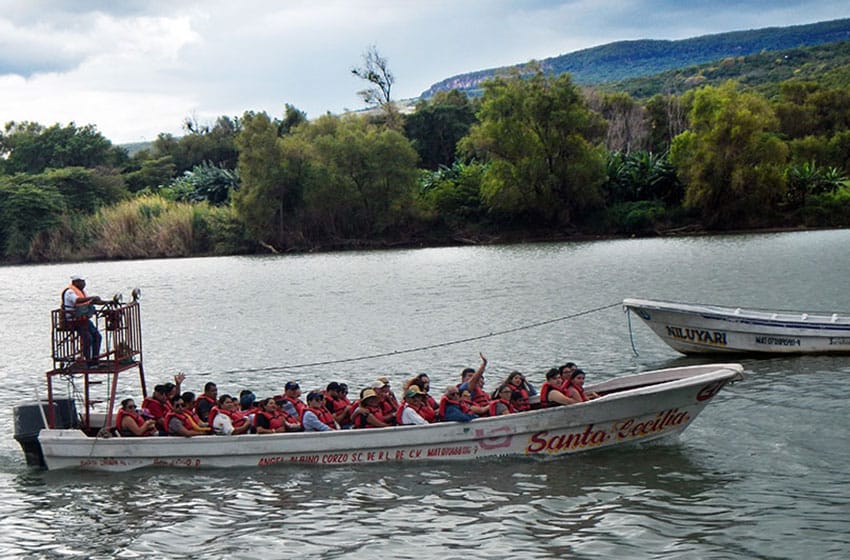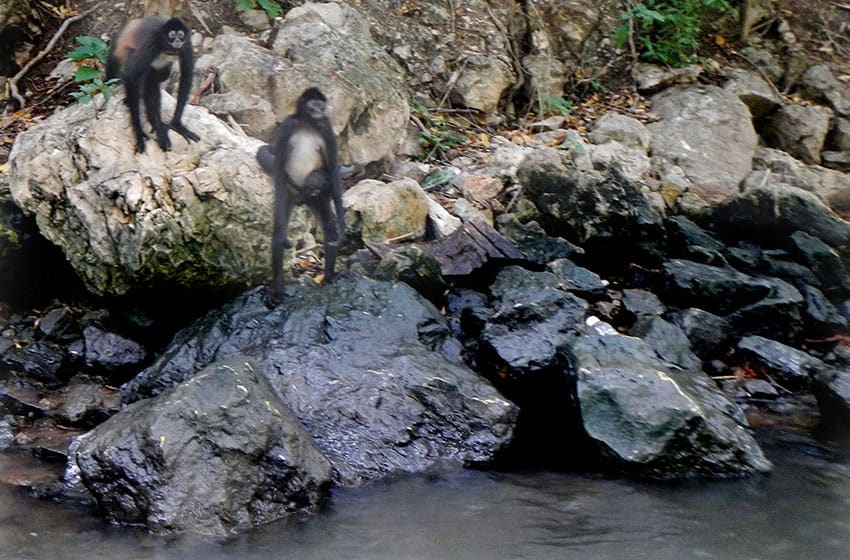A visit to Tuxtla Gutiérrez, the capital of the state of Chiapas, would never be complete — so I was told — without a boat trip through the nearby Cañon del Sumidero, whose vertical walls tower up to 1,000 meters above the rather narrow Grijalva river.
When I looked up sumidero I discovered that one of its meanings is “cesspool” which was not very encouraging until I learned that this canyon was one of the favorite haunts of the founder of the Tuxtla zoo, biologist Miguel Álvarez del Toro. If Mexico’s most famous conservationist loved this place, then I had to see it for sure.
Trips down the river are organized from several docks alongside the little town of Chiapa de Corzo which, I was surprised to learn, had for a brief time been the state capital. The word chiapa, by the way, appears to be a short form of the word tepechiapan, which means “water below the hill,” a fitting description of the Grijalva river flowing through kilometer-high walls of rock.
“It’s better to take that boat ride in the morning, rather than later in the day,” a local taxi driver told us. “The boat men won’t leave until they have enough customers to fill every single seat, so people who go to Chiapa de Corzo late in the afternoon may find themselves sitting around forever waiting for their tour to start.”
As for us, we only had to wait half an hour. Then lifejackets were assigned to each of us. Although it looked like it was going to rain, we learned that umbrellas were forbidden.

Since these boats are uncovered, to allow for a good upward view of the canyon walls I would suggest you bring along a waterproof poncho if rain seems likely.
A warm jacket is another good idea. Even on a sunny day, the boats travel at high speeds along much of the river, generating a strong breeze with plenty of spray.
Here you may be wondering: is it all worthwhile?
The answer, in my opinion, is a resounding sí que sí: absolutely yes! There is much more to this canyon than high walls. The farther you go downriver, the more obvious it becomes that there is something wonderful, something magical about it. One moment you are overwhelmed by majesty and grandeur and the next you’re seduced by a spray of wildflowers and then your heart is touched by the affection and clowning antics of child-like spider monkeys who are obviously fast friends with the boatmen who ferry us tourists up and down the river.
You are mesmerized by rocky crags high, high above you, but when you glance back down at the river you see an elegant white egret posing on a slender wand protruding from the water or suddenly discover a big brown pelican floating right next to you. Another glance and you spot a huge, lazy crocodile sprawled over a rocky outcrop, taking the sun.
And if you brought along those binoculars, you may even get to see a cinnamon hummingbird pollinating the wildflowers.

I was, of course, curious to see how Chiapas is dealing with the problem of pollution in this important river. In Jalisco, where I live, the waters of the Santiago river, which skirts the city of Guadalajara, are not only toxic, but so filled with human waste that the stench is unbearable, all this despite some of the strictest anti-pollution laws in the world.
I am happy to report that during 90% of our river trip we noticed nothing amiss. The water appeared clean and smelled fine. This is apparently due to the daily removal of over 30 tonnes of trash, much of which consists of tree branches and natural debris washed into the river by the rains. Unfortunately, during the other 10% of the time we did find little coves where all sorts of things were floating on the surface but this Sumidero is definitely no cesspool!
In fact, when it comes to caring for their most famous river, it looks to me like Chiapas is far ahead of Jalisco.
Some 120 boats carry visitors along the 30-kilometer stretch between the two docks at Chiapa de Corzo and the Chicoasén hydroelectric dam downriver. These boats are sturdy, the guides are very well trained, and everyone on board is obliged to wear a lifejacket. In addition, there are ambulance boats anchored along the riverside, on call all day long.
This professional approach, however, came at a price. Years ago the boats were old and leaky and even kids could be guides. This situation generated a spate of accidents, some fatal. The government responded with suspensions and fines and took 60 boats out of circulation. Today, the situation has reversed itself and the boat cooperatives are proud of their new, high standards.
As a result, around 300,000 people take the boat ride down the Grijalvo river every year, making the Cañon del Sumidero the second most popular site in Chiapas, after Palenque.
[soliloquy id="96861"]
Our voyage down the river run ended much too soon at the foot of the dam which, all by itself, generates over 30% of all the hydroelectric power produced in Mexico.
Here we found two “floating Oxxos” awaiting us with junk food. The magic spell was broken. Back to business.
But I returned home slightly changed. I may not be able to voice it, but I did experience something unique in this tall river canyon and before we debarked all of us applauded our guide as we would the conductor of a symphony orchestra, for he had been instrumental in making our lives just a little bit richer.
Oh, yes, the Sumidero Canyon is well worth it.
The writer has lived near Guadalajara, Jalisco, for more than 30 years and is the author of A Guide to West Mexico’s Guachimontones and Surrounding Area and co-author of Outdoors in Western Mexico. More of his writing can be found on his website.
CORRECTION: An observant reader pointed out that we had reversed the flow of the Grijalva river. In fact, it flows north so the Sumidero Canyon is downriver from Chiapa de Corzo. We apologize for the error.
